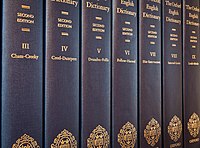ISO 3166 is a standard published by the International Organization for Standardization (ISO) that defines codes for the names of countries, dependent territories, special areas of geographical interest, and their principal subdivisions. The official name of the standard is Codes for the representation of names of countries and their subdivisions.

The International Organization for Standardization is an international standard-setting body composed of representatives from various national standards organizations.
In computing, AAP DTD is a set of three SGML Document Type Definitions for scientific documents, defined by the Association of American Publishers. It was ratified as a U.S. standard under the name ANSI/NISO Z39.59 in 1988, and evolved into the international ISO 12083 standard in 1993. It was supplanted as a U.S. standard by ANSI/ISO 12083 in 1995.
A document management system (DMS) is a system used to receive, track, manage and store documents and reduce paper. Most are capable of keeping a record of the various versions created and modified by different users. In the case of the management of digital documents such systems are based on computer programs. The term has some overlap with the concepts of content management systems. It is often viewed as a component of enterprise content management (ECM) systems and related to digital asset management, document imaging, workflow systems and records management systems.
Documentation is any communicable material that is used to describe, explain or instruct regarding some attributes of an object, system or procedure, such as its parts, assembly, installation, maintenance and use. Documentation can be provided on paper, online, or on digital or analog media, such as audio tape or CDs. Examples are user guides, white papers, online help, and quick-reference guides. Paper or hard-copy documentation has become less common. Documentation is often distributed via websites, software products, and other online applications.
The International Standard Bibliographic Description (ISBD) is a set of rules produced by the International Federation of Library Associations and Institutions (IFLA) to create a bibliographic description in a standard, human-readable form, especially for use in a bibliography or a library catalog. A preliminary consolidated edition of the ISBD was published in 2007 and the consolidated edition was published in 2011, superseding earlier separate ISBDs for monographs, older monographic publications, cartographic materials, serials and other continuing resources, electronic resources, non-book materials, and printed music. IFLA's ISBD Review Group is responsible for maintaining the ISBD.
ISO 4 is an international standard which defines a uniform system for the abbreviation of serial publication titles, i.e., titles of publications such as scientific journals that are published in regular installments.
Office Open XML is a zipped, XML-based file format developed by Microsoft for representing spreadsheets, charts, presentations and word processing documents. The format was initially standardized by the Ecma, and by the ISO and IEC in later versions.
ISO 2709 is an ISO standard for bibliographic descriptions, titled Information and documentation—Format for information exchange.
Geospatial metadata is a type of metadata applicable to geographic data and information. Such objects may be stored in a geographic information system (GIS) or may simply be documents, data-sets, images or other objects, services, or related items that exist in some other native environment but whose features may be appropriate to describe in a (geographic) metadata catalog.
ISO/TC 46 is Technical Committee 46 of the International Organization for Standardization (ISO), responsible for Information and documentation.
ISO 80000 or IEC 80000 is an international standard introducing the International System of Quantities (ISQ). It was developed and promulgated jointly by the International Organization for Standardization (ISO) and the International Electrotechnical Commission (IEC).

ISO/TC 37 is a technical committee within the International Organization for Standardization (ISO) that prepares standards and other documents concerning methodology and principles for terminology and language resources.
A specification often refers to a set of documented requirements to be satisfied by a material, design, product, or service. A specification is often a type of technical standard.

Metadata is "data that provides information about other data", but not the content of the data, such as the text of a message or the image itself. There are many distinct types of metadata, including:
Technical documentation is a generic term for the classes of information created to describe the use, functionality or architecture of a product, system or service.
ISO/IEC JTC 1/SC 7 Software and systems engineering is a standardization subcommittee of the Joint Technical Committee ISO/IEC JTC 1 of the International Organization for Standardization (ISO) and the International Electrotechnical Commission (IEC), that develops and facilitates standards within the field of engineering of software products and systems. The international secretariat of ISO/IEC JTC 1/SC 7 is the Bureau of Indian Standards (BIS) located in India.

Citing Medicine: The NLM Style Guide for Authors, Editors, and Publishers is the style guide of the United States National Library of Medicine (NLM). Its main focus is citation style and bibliographic style. The citation style of Citing Medicine is the current incarnation of the Vancouver system, per the References > Style and Format section of the ICMJE Recommendations. Citing Medicine style is the style used by MEDLINE and PubMed.
The International Standard Link Identifier (ISLI), is an identifier standard. ISLI is a universal identifier for links between entities in the field of information and documentation. It was developed by the International Organization for Standardization (ISO) and published on May 15, 2015. ISO/TC 46/SC 9 is responsible for the development of the ISLI standard.
ISO 12083 is an international SGML standard for document interchange between authors and publishers. It features separate Document Type Definitions for books, serials, articles, and math. Derived from AAP DTD, it was first published in 1993, revised in 1994, and last confirmed in 2016.



